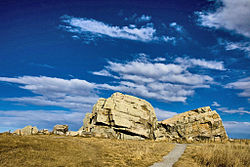Foothills Erratics Train
From Wikipedia, the free encyclopedia
Big Rock
Another source:
Foothills Erratics Train
In
southern Alberta, along the eastern side of the Rocky Mountains,
thousands of large boulders (erratics) form a train over 600 kilometres
long.
These rocks contain clues that have helped scientists to understand the
movements of the ice sheets that covered Canada during the ice age.
When
geologists examined the rocks, they discovered that they were all made
of the same kind of rock, and they traced the source of that
rock to an area around Mount Edith Cavell in Jasper Park. Thousands of
years ago, these large stones fell onto the surface
of the Cordilleran ice sheet during a landslide, and then were slowly carried by the ice sheet outward
onto the Plains. When the ice melted, a long train of boulders was left behind.
The
pathway of the erratics train reveals the direction in which the ice
sheet travelled. The rocks take a sharp right-angle turn out on the
Plains, changing from an easterly to a southerly direction. Scientists
believe that the western Cordilleran ice sheet "bumped into" the
eastern Laurentide ice sheet, and got deflected southward. This shows that the two ice sheets were
joined together, and no "ice free corridor" could have existed between them until later, when the glaciers started to melt.

This example of a Foothills Erratic is located near Glenwoodville, Alberta.

No comments:
Post a Comment